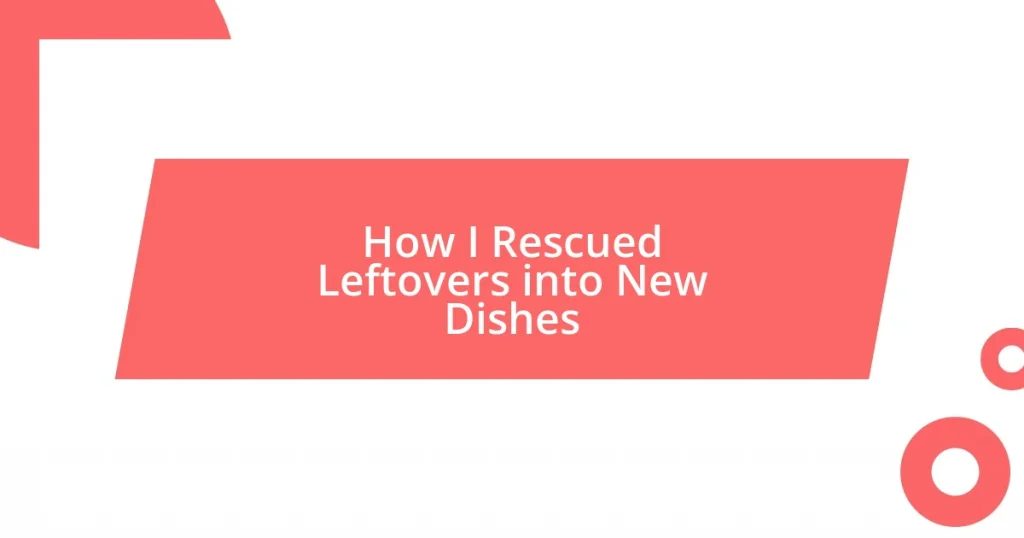Key takeaways:
- Food waste is a significant issue, with one-third of global food produced ending up in landfills, highlighting the need for more mindful grocery shopping and meal planning.
- Creative use of leftovers, such as transforming them into new dishes like frittatas or stir-fries, not only reduces waste but also brings variety to meals.
- Effective meal planning and proper storage techniques, like pre-portioning and labeling leftovers, can minimize waste and enhance kitchen organization.
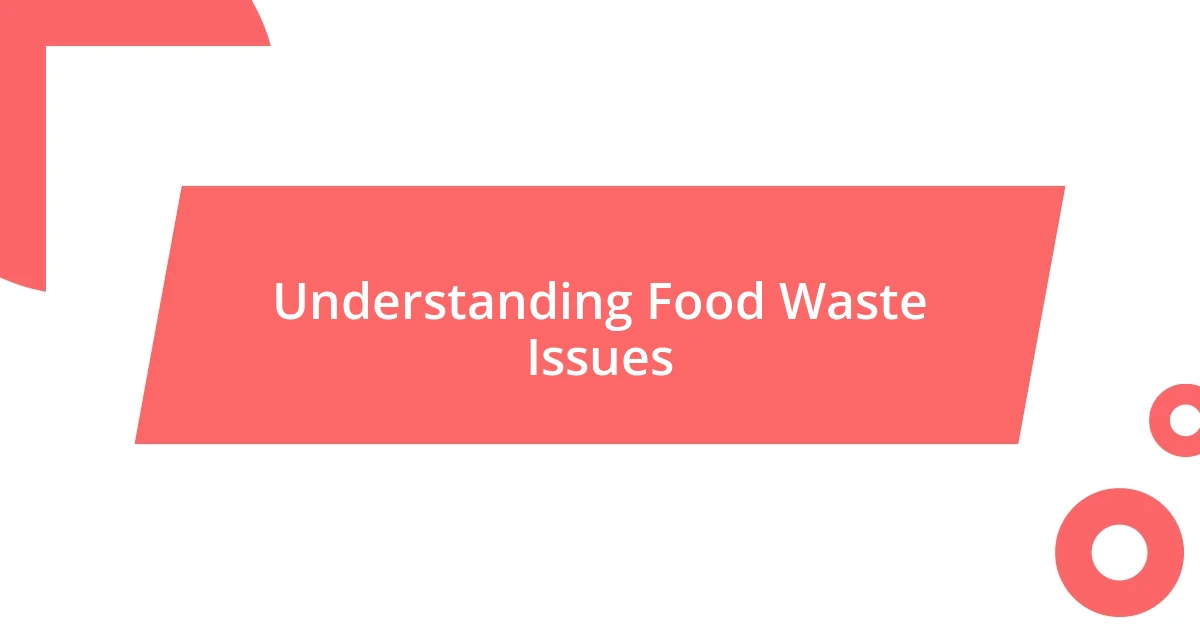
Understanding Food Waste Issues
Food waste is not just an environmental issue; it’s a personal concern that weighs heavily on my heart. I remember a time when I carelessly tossed out a heaping plate of leftovers, thinking little of it. Later, as I learned about the staggering statistic that one-third of all food produced globally ends up in landfills, I felt a twinge of guilt. How can we let that happen when so many people face hunger each day?
One can’t help but wonder, why do we waste food so easily? In my own kitchen journey, I’ve discovered that the problem often lies in our relationship with grocery shopping and meal prep. We often buy more than we need, driven by the fear of missing out on seasonal ingredients or sales. Each time I overfill my cart, I remind myself of the times when perfectly good food ended up in the trash. It’s a painful reminder of the resources used to produce that food, from water to labor.
When I delve deeper into food waste, I see the bigger picture of its impact. It’s more than just a financial loss; it contributes to greenhouse gas emissions, intensifying climate change. The emotional weight of this realization ignites a passion in me to be more mindful. I often ponder, wouldn’t it be wonderful if we could not only prevent waste but also create something wonderful from what we already have?
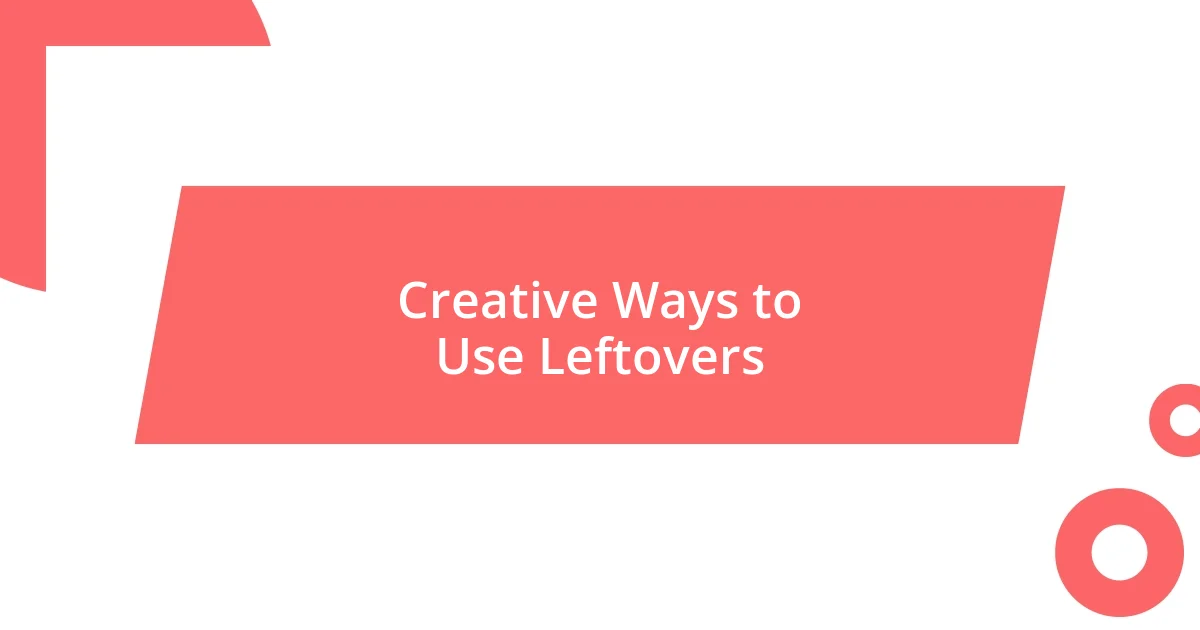
Creative Ways to Use Leftovers
Finding creative uses for leftovers has been a game-changer in my kitchen. For example, I often transform roasted vegetables into a hearty frittata. Just whisk some eggs, add in those flavorful veggies, and pop it in the oven. It’s like giving yesterday’s meal a fresh start, and the best part? It feels like I’m indulging in a whole new dish without much effort!
Another favorite of mine is to turn leftover grilled chicken into a zesty chicken salad. By combining it with some Greek yogurt, fresh herbs, and a squeeze of lemon, I create a delicious, protein-packed lunch. I love how simple alterations can breathe new life into last night’s dinner, showcasing how resourcefulness can be delicious.
I’ve also had success with leftover rice. A sizzling stir-fry comes to life when I toss it with some random veggies and an egg. It’s quick, satisfying, and a fantastic way to clean out the fridge. Doesn’t it feel great to whip up something spontaneous from what seems like kitchen clutter?
| Leftover | New Dish |
|---|---|
| Roasted Vegetables | Frittata |
| Grilled Chicken | Chicken Salad |
| Cooked Rice | Stir-Fry |

Planning Meals to Minimize Waste
Planning meals with the intention of minimizing waste has truly transformed my approach in the kitchen. I vividly recall a chaotic week when I realized I was constantly buying the same ingredients, only to find them wilting away in my fridge. Since then, I’ve adopted the habit of making a meal plan before shopping. This not only curbs impulse buys but also helps me use every bit of what I buy, making me feel like I’m in control of my food journey.
Here are some strategies I’ve found helpful for planning meals that minimize waste:
- Create a Weekly Menu: I jot down meals for the week, ensuring I incorporate ingredients I already have, which reduces redundant purchases.
- Check Inventory: Before shopping, I take stock of what’s in my pantry and fridge. This simple step has saved me from buying duplicate items.
- Batch Cooking: I often prepare larger portions of meals that can be easily adapted. For instance, a big batch of quinoa can become a base for salads, bowls, or stir-fries throughout the week.
- Shopping Lists: I make a detailed shopping list based on my meal plan. Sticking to this list has really helped me avoid the temptation of “just browsing” the aisles.
- Flexible Recipes: I look for recipes that allow substitutions, so if I have leftover veggies, I don’t feel restricted and can easily incorporate them into my meals.
By embracing these strategies, I’ve discovered a sense of accomplishment in creating meals that not only delight the palate but also embody a commitment to sustainability.
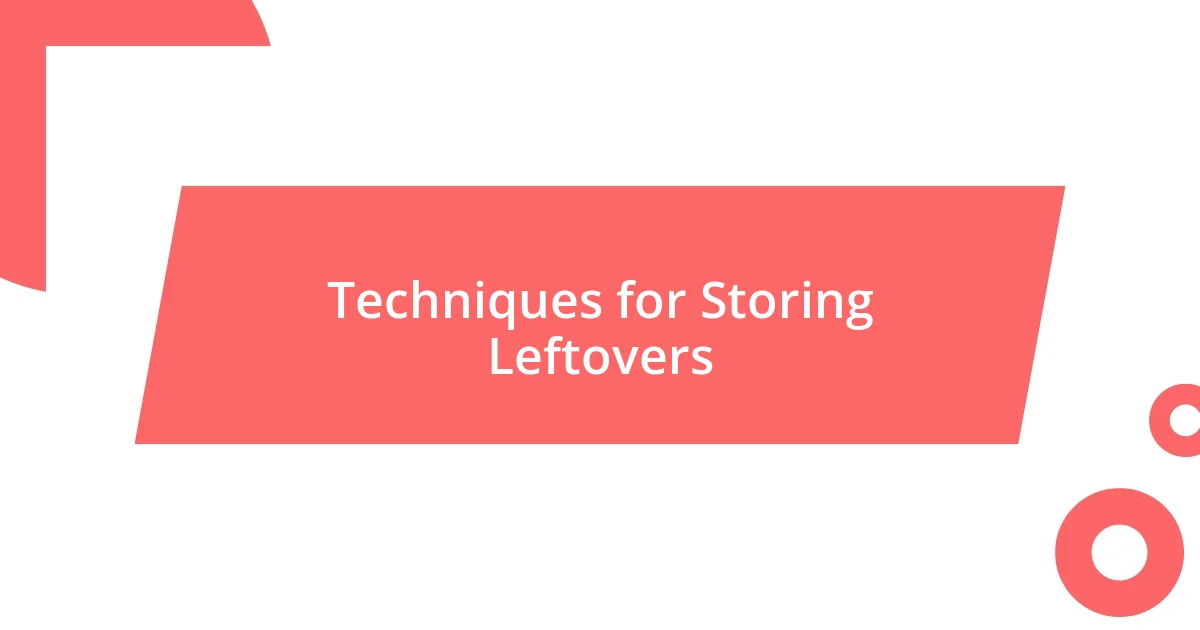
Techniques for Storing Leftovers
When it comes to storing leftovers, I’ve learned that the right containers can make all the difference. I remember a time when I’d just shove everything into mismatched Tupperware, which often led to unexpected spills or, worse, food that didn’t last. Now, I invest in clear, airtight containers. Being able to see what I have on hand not only helps prevent waste but also sparks my creativity about what to whip up next.
I like to put certain leftovers in smaller portions, too. For instance, I often divide soups or casseroles into single-serving jars before refrigerating them. This way, they’re ready for quick lunches when life gets hectic. Sometimes, I find myself asking, “What if I’m in a rush tomorrow?” By pre-packaging them, the answer becomes effortless satisfaction instead of last-minute takeout.
One technique that genuinely changed how I manage my leftovers is labeling. I used to forget when I made something and would be left wondering if it was still good to eat. Now, I make it a point to label each container with the date and a quick note about what’s inside. It may sound simple, but it’s an easy step that takes my meal prep game to the next level. Plus, it simply feels good to know that my fridge isn’t just a jumble; it’s an organized treasure trove of potential meals!

Transforming Leftovers into New Dishes
Revamping leftovers into new dishes can be incredibly satisfying. Recently, I had a batch of roasted vegetables left over from dinner, and instead of letting them languish in the fridge, I decided to make a vibrant frittata. The act of transforming those neglected veggies into a hearty breakfast not only reduced waste but also brought joy to my morning routine. I can’t help but wonder, isn’t it amazing how a simple change in perspective can turn what’s left into something special?
I also love the idea of creating “kitchen sink” meals. The other day, I found myself with a mishmash of ingredients: some cooked rice, a few sad-looking mushrooms, and an old bell pepper. Rather than see these as scraps, I whipped up a comforting stir-fry, adding a splash of soy sauce and a sprinkle of sesame seeds. The result was a dish that felt fresh and new, made entirely from what I had on hand. It made me reflect: how often do we overlook the potential of our leftovers?
For me, the key is experimentation. I remember a time when I was hesitant to mix flavors, worried about whether they’d mesh well. But then I paired leftover chili with baked potatoes, and it was a game changer. I had taken something simple and turned it into a cozy comfort dish. This experience really taught me that when it comes to leftovers, the only real limitation is my imagination. What could you create with what you already have?
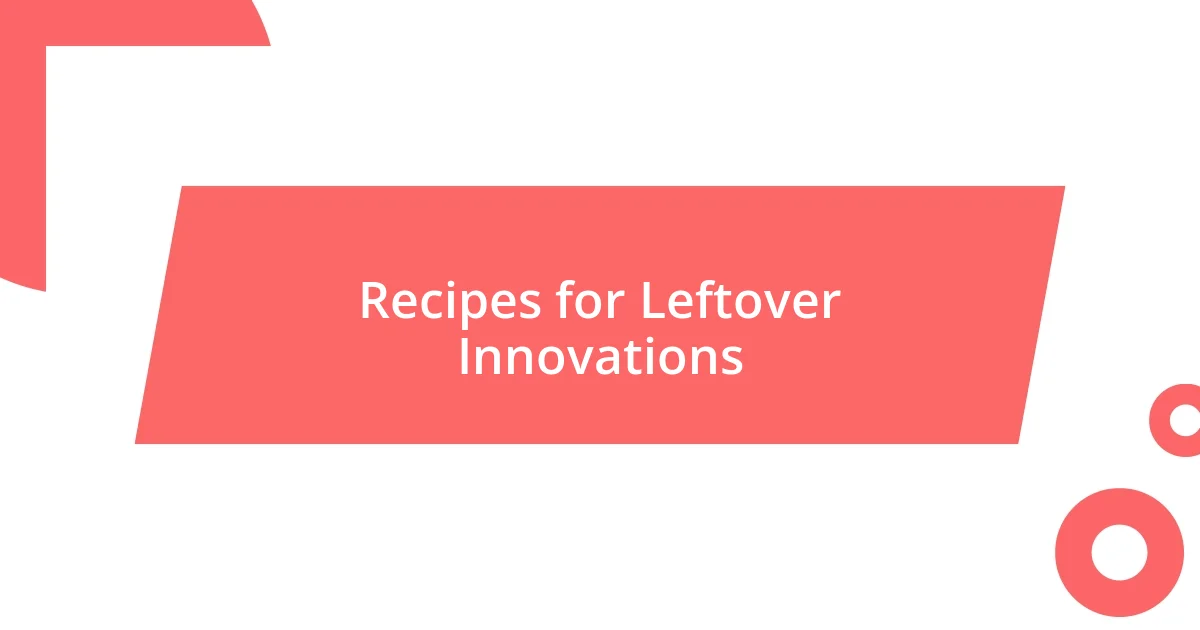
Recipes for Leftover Innovations
I often find that leftover pasta can be transformed into a delightful pasta bake. Just the other day, I opened my fridge to discover a half-eaten spaghetti portion looking rather lonely. Instead of just reheating it, I tossed it into a baking dish, added some cheese and leftover veggies, and threw it in the oven. The bubbling cheese and crispy edges made me realize how such a simple transformation could breathe life into a dish that I might have otherwise dismissed.
When I have a variety of cooked proteins in the fridge—maybe some grilled chicken, shrimp, or beef—you can bet that a hearty salad is in my future. I remember one particular instance where I mixed chopped chicken with fresh greens, a dollop of hummus, and a sprinkle of nuts. The blend of flavors was not just refreshing; it made me feel proud to unveil a dish that showcased my frugal creativity. How often do we forget that a simple salad can be an exciting canvas for leftovers?
The thrill of reinventing leftovers often leads to unexpected culinary adventures. Once, I had some leftover curry that had overstayed its welcome. Instead of reheating, I decided to make curry-infused rice cakes. Simply mixing the curry into rice, shaping them into patties, and pan-frying them was a revelation. The crunchiness of the exterior combined with the warmth of the curry inside was seriously comforting. Have you ever thought about transforming your leftovers in such fun ways? It’s incredible how a touch of creativity can turn what we see as waste into something utterly delightful.










